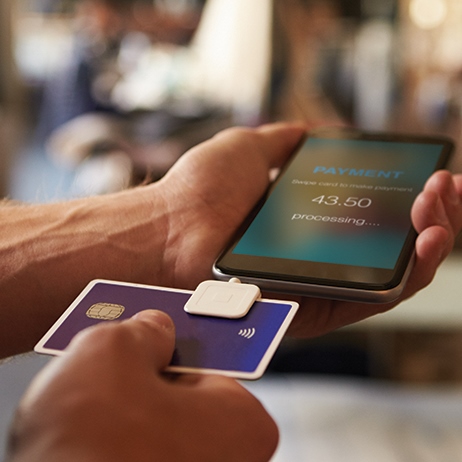Does the impact of mobile payments technology impact the economy?
Over the past two decades, digital services have transformed economies and lives across the world. Smartphones and mobile phone apps have affected our everyday lives from the way we commute (e.g., Uber, Lyft) and purchase groceries (e.g., Instacart, Amazon) to how we pay bills. With the rapid development of smartphone and financial technology, mobile wallet payment transactions have skyrocketed. In fact, the total transaction value worldwide through mobile payments exceeded $350 billion by 2017 and is expected to grow to an annual rate of 39% to over $1.6 trillion by 2022 (Statista 2018).
A recent academic paper published in the American Economic Association’s Papers and Proceedings studied the introduction of mobile-payment technology in Singapore to examine its impact on the economy.¹ Specifically, the authors studied a dataset of 250,000 bank account holders from a Singaporean bank from 2016 to 2018 to observe these consumers’ mobile wallet transactions, as well as their ATM, debit, and credit card transactions. Singapore has been moving toward a cashless society, and the fast development in mobile payments plays a critical role. On April 13, 2017, Singapore introduced the use of the Quick Response (“QR”) code payment function in the mobile wallet. This technology enables users to receive and make immediate payments by generating their own QR code in the mobile phone app. Buyers and sellers of goods and services can complete a transaction by displaying or scanning QR codes. This technology not only brings convenience to consumers, but also reduces transaction costs, which is especially impactful for small and new businesses.
The authors observe a significant increase in mobile wallet usage from Singaporean bank account holders after the QR code-payment introduction. For both the transaction amount and transaction counts, the mobile wallet transactions stay relatively flat before April 2017. Upon the introduction of new QR code-payment technology, the monthly transaction amount and count start to trend up almost immediately. In contrast, ATM monthly withdrawals stay rather stable throughout the year, suggesting that the rise of mobile wallet transactions is not simply driven by a reduction in cash usage. The authors also bifurcated their data by transaction size and find that the increase in the number of small-size transactions greatly outnumbers that of large-size transactions, suggesting that consumers respond to the new payment technology by using the mobile wallet more frequently, especially for small-sized transactions.
The authors also analyzed the data to determine if the monthly transaction amount in mobile wallet transactions by the consumer is merely a substitutable payment method for credit/debit cards. They find that, in support of an increase in spending after the introduction of a mobile-payment technology, debit and credit card sales increase by about 3.5% per month, especially for small and entrepreneurial firms. The authors note that one plausible explanation for the aforementioned card spending increase is that the new mobile-payment technology reduces transaction frictions by shortening transaction time, which could promote demand for goods and lead to a genuine increase in spending. They investigated this hypothesis and found corroborative evidence. Small and new merchants attract more new customers after the technology is introduced. Cardsales growth does not merely reflect a change in payment behavior by existing customers; the payment convenience generates additional demand by driving retail traffic. New merchants possess a less stable customer base and thus will receive a greater benefit from an increase in consumer traffic.
This paper contributes to the Fintech and digitization literature in that it finds evidence that the enhanced convenience in mobile wallet payment fosters real business growth, especially for new and small businesses, and is not merely a substitutable payment mechanism. The world is shifting to a digital consumer economy. It is important for economies to understand how mobile wallet payments affect economic growth, as well as understand that generational differences exist in managing money and engaging in transactions which will also impact how these financial transactions are conducted.
¹ Agarwal, Sumit, Wenlan Qian, Bernard Y. Yeung, and Xin Zou, “Mobile Wallet and Entrepreneurial Growth,” AEA Papers and Proceedings 2019, 109:48-53


